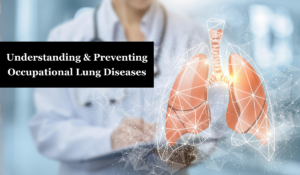Occupational lung diseases pose a significant threat to the respiratory health of workers across various industries. In fact, occupational lung diseases remain the primary cause of occupation-associated illness in the U.S.
Fortunately, although many pose potentially life-altering dangers, you and your team can take steps to prevent them from occurring.
Because individuals spend a substantial portion of their lives in the workplace, understanding the causes, symptoms, and preventive measures of occupational lung diseases is crucial.
Here, we’ll delve into the realm of occupational lung diseases, categorizing them into those caused by organic dust and inorganic dust, while emphasizing the importance of proactive workplace measures.
Let’s break it down.
Related Article: Understanding & Preventing COPD In the Workplace
Related Article: How to Protect Your Team from the Effects of Silica

Causes and Symptoms of Occupational Lung Diseases
Common Causes:
Occupational lung diseases often result from prolonged exposure to airborne particles, chemicals, and pollutants in the workplace.
Workers in industries such as mining, construction, agriculture, and manufacturing are particularly vulnerable. The primary culprits include organic dust, inorganic dust, gases, vapors, and fumes.
Common Symptoms:
Symptoms of occupational lung diseases can range from mild to severe and may include persistent coughing, shortness of breath, chest pain, wheezing, and fatigue.
Early detection and intervention are crucial in managing these conditions effectively.
Workplace Lung Diseases Caused by Organic Dust
Byssinosis (Brown Lung Disease):
Byssinosis affects textile workers–both former and current–and almost exclusively those who work with unprocessed cotton.
Causes: Cotton, flax, or hemp dust exposure.
Symptoms: Chest tightness, wheezing, coughing.
Woodworker’s Lung:
This disease varies in intensity, clinical presentation, and natural history depending on the inciting agent, as well as the intensity of exposure. In most cases, woodworker’s lung disease can be reversed with prompt diagnosis followed by identification and removal of exposure risks.
Causes: Wood dust exposure.
Symptoms: Cough, fever, difficulty breathing.
Hypersensitivity pneumonitis:
There are variations of hypersensitivity pneumonitis depending on the occupation, including cork worker’s lung, farmer’s lung, and mushroom worker’s lung.
Causes: inhalation of fungus spores from moldy hay, bird droppings, and other organic dusts.
Symptoms: inflamed air sacs in the lungs, leading to fibrous scar tissue in the lungs, abnormal breathing, coughing and fever.
Occupational asthma:
People at higher risk for occupational asthma often work in manufacturing and processing operations, farming, animal care, food processing, cotton and textile industries, and refining operations.
Causes: inhaling certain irritants in the workplace, such as dusts, gases, fumes, and vapors. It is the most common form of occupational lung disease and can worsen already-existing asthma.
Symptoms: common asthma symptoms (such as a chronic cough and wheezing).
Diseases Caused by Inorganic Dusts
Asbestosis:
Asbestosis is believed to primarily be an occupational disease.
There are reports of secondhand exposure to asbestos-containing dust. The American Lung Association estimates that 2,000 to 3,000 individuals are diagnosed with mesothelioma (a type of cancer linked to asbestos) each year in the U.S.
Causes: Prolonged exposure to asbestos fibers.
Symptoms: Shortness of breath, persistent cough, chest pain.
Silicosis:
Silicosis is a type of pulmonary fibrosis, caused by breathing in respirable silica dust. Often created during the grinding, cutting, mining, or demolition of cement or stone, it’s one of the most common hazards faced by workers across the nation.
Over one million workers per year are exposed to silica.
Causes: Inhalation of crystalline silica dust (common in mining and construction).
Symptoms: Cough, fatigue, severe shortness of breath.
Coal Worker’s Pneumoconiosis (Black Lung Disease):
One of the most notorious and famous occupational lung diseases, around 16% of coal miners have coal worker’s pneumoconiosis.
Causes: Inhalation of coal dust.
Symptoms: Chronic cough, difficulty breathing.
Workplace Preventive Measures
- Engineering Controls:
- Ventilation Systems: Implementing effective ventilation systems to reduce the concentration of airborne particles in the workplace.
- Dust Suppression: Using water or dust suppressants to minimize the dispersal of dust during activities like cutting, grinding, or excavation.
- Personal Protective Equipment (PPE):
- Respirators: Providing appropriate PPE, such as N95 masks, to workers exposed to airborne contaminants.
- Protective Clothing: Equipping workers with protective clothing to minimize skin exposure to harmful substances.
- Work Practices:
- Regular Monitoring: Conducting regular air quality monitoring to identify potential hazards and adjusting work practices accordingly.
- Job Rotation: Implementing job rotation to limit prolonged exposure to specific contaminants.
- Education and Training:
- Awareness Programs: Conducting educational programs to raise awareness about the risks of occupational lung diseases and the importance of preventive measures.
- Training on Safe Practices: Providing comprehensive training on safe work practices, including proper handling of hazardous substances.
- Health Surveillance:
- Regular Health Check-ups: Establishing routine health check-ups for workers exposed to respiratory hazards to detect early signs of lung diseases. Monitoring the health of workers through periodic medical examinations and maintaining detailed health records.
- Smoking Cessation: Quitting smoking can actually decrease the risk for occupational lung disease, in addition to providing innumerable other benefits, too. Offering smoking cessation programs and providing nicotine-replacement products, such as nicotine patches or gums, is a key step that can yield dividends to you and your business.
- Regulatory Compliance:
- Compliance with Regulations: Ensuring strict adherence to OSHA regulations relevant to specific industries. Regulations regarding which PPE to use, exposure limits, respirator fit-testing, and much more, all exist for a reason.
Complying with your industry’s regulations not only helps keep your team healthy, but also prevents your company from facing stiff fines and penalties.
Key Takeaways
By and large, occupational lung diseases remain preventable.
But, safeguarding the respiratory health of workers requires a comprehensive approach.
By understanding the causes, symptoms, and preventive measures related to organic and inorganic dust exposure, you can create environments that prioritize the well-being of your employees.
Through engineering controls, proper PPE, work practices, education, and health surveillance, your business can foster a safer and healthier atmosphere, allowing your team to breathe easy in their professional pursuits.
About Worksite Medical
In most cases, OSHA requires medical surveillance testing, and at no cost to employees.
Worksite Medical makes that program easier with mobile medical testing.
We conduct on-site respirator fit tests, as well as audiometric exams, pulmonary function tests and heavy metal lab work, right on your job site. We also keep accurate, easy-to-access medical records for your convenience. You’ll keep your employees at work, and stay ahead of OSHA inspections.




